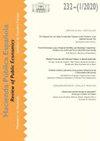评估拉丁美洲和加勒比地区的财政绩效:基于原始数据集的结构平衡估算
IF 0.7
4区 经济学
Q3 ECONOMICS
Hacienda Publica Espanola-Review of Public Economics
Pub Date : 2016-01-01
DOI:10.7866/HPE-RPE.16.4.3
引用次数: 1
摘要
近年来,越来越多的国家开始根据以周期调整或结构性(而非实际)平衡为目标的规则来确定其财政政策框架,以克服顺周期性和财政波动性的问题。这样做的逻辑在原则上是令人信服的:基于规则的财政政策允许自动稳定器在周期中自由发挥作用,并有助于在经济繁荣时期积累财政盈余。然而,结构平衡的估计受到一些方法上的挑战,包括估计不确定性的程度。本文提出了一系列对结构性预算平衡的估计,并用它们来分析拉丁美洲和加勒比地区财政政策的周期性行为。基于包含1990年至2014年该地区20个国家详细财政信息的原始数据集,本文发现,对于一些国家,特别是那些从商品相关活动中获得大量财政收入的国家,估计范围可能很大。此外,有证据表明,平均而言,该地区遵循了顺周期的政策模式:产出缺口每增加1%,结构性初级平衡就会恶化0.55个百分点。这种模式掩盖了巨大的区域异质性:顺周期性在面临较大贸易冲击的国家更为明显,但可以通过较高的制度质量加以抵消。本文章由计算机程序翻译,如有差异,请以英文原文为准。
Evaluating Fiscal Performance in Latin America and the Caribbean: Structural Balance Estimates from an Original Dataset
In recent years, an increasing number of countries have began anchoring their fiscal policy frameworks in terms of rules that target the cyclically adjusted or structural (as opposed to actual) balance in an effort to overcome problems of procyclicality and fiscal volatility. The logic for doing so is in principle compelling: rule-based fiscal policies allow automatic stabilizers to work freely during the cycle and help accumulate fiscal surpluses in good times. However, the estimation of structural balances is subject to a number of methodological challenges, including the degree of estimation uncertainty. This paper presents a range of estimates of the structural budget balance and uses them to analyze the cyclical behavior of fiscal policy in Latin America and the Caribbean. Based on an original dataset comprising detailed fiscal information from 20 countries across the region between 1990 and 2014, the paper finds that the range of estimates can be large for some countries, especially those that derive substantial fiscal revenue from commodity-related activities. In addition, the evidence shows that on average, the region has followed a procyclical policy pattern: a 1 percent increase in the output gap is associated with up to a 0.55 percentage point deterioration in the structural primary balance. This pattern hides substantial regional heterogeneity: procyclicality is more marked in countries that face large terms of trade shocks, but it can be counteracted by higher institutional quality.
求助全文
通过发布文献求助,成功后即可免费获取论文全文。
去求助
来源期刊

Hacienda Publica Espanola-Review of Public Economics
Economics, Econometrics and Finance-Finance
CiteScore
0.90
自引率
14.30%
发文量
14
期刊介绍:
Hacienda Pública Española/Review of Public Economics welcomes submissions on all areas of public economics. We seek to publish original and innovative research, applied and theoretical, related to the economic analysis of Government intervention. For example, but not exclusively: Taxation, Redistribution, Health, Education, Pensions, Governance, Fiscal Policy and Fiscal Federalism.
In addition to regular submissions, the journal welcomes submissions of:
-Survey Reviews, containing surveys of the literature regarding issues of interest in the Public Economics field;
-Policy oriented reviews, showing the current contributions of Public Economics in relation to relevant contemporary issues affecting public decision-makers in the real world (Policy Watch);
-Comments of previously published articles. Contributions to this section should be limited to a maximum of 2 000 words (12 pages). If deemed adequate, the authors of the commented article will be given the opportunity to react in a Reply. Both Comment and Reply will be published together.
Articles for the Survey Reviews and Policy Watch section are subject to the same double blind reviwing procedure. The adequacy of Comments submitted for publication will be evaluated by the Executive Editors.
 求助内容:
求助内容: 应助结果提醒方式:
应助结果提醒方式:


